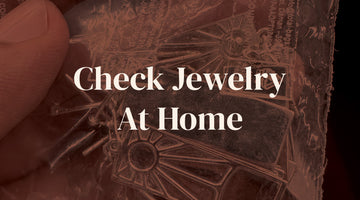Let’s be real. We’ve all had that moment where we glance at a silver piece - be it jewelry, cutlery, or a decorative item - and wonder, “Is this even legit?” Especially if you just snagged it at a garage sale or from that one friend who swears it’s real silver. Cue the internal dialogue: “Is this thing even worth anything?”
Well, you don’t need a lab coat or a trip to a jeweler to figure it out. You can easily check silver at home with just a few simple tests. And yes, this can be done without turning your kitchen into a science experiment (though a little drama never hurt anyone, right?). So let’s immerse ourselves into the wizardy world of silver purity checks and uncover whether your ‘silver’ is the real deal or just a shiny imposter.
Also Read: Sterling Silver vs. Normal Silver: The Ultimate Showdown
1. The Magnet Test: Is It Pulling You In?
This is hands down the easiest test, and it doesn’t even require getting your hands dirty. You just need a strong magnet (not one of those weak fridge magnets from your last vacation). Here’s the deal - silver isn’t magnetic. So if you place a magnet near your silver piece and it sticks like glue, then sorry to burst your bubble, but that ain’t real silver.
How to Do It:
- Grab a strong magnet (go ahead and grab from your toolbox, or that one drawer everyone has full of random things).
- Hold it close to your silver item.
- If the magnet attracts the piece, Houston, we have a problem. It’s most likely fake or mixed with some non-silver metals.
Pro Tip:
Even if the magnet doesn’t stick, that doesn’t mean you’re holding pure silver. Some metals used in fake silver blends also aren’t magnetic, so let’s not call it a victory just yet.
2. The Ice Cube Test: Cool as Ice (Silver)
Silver is a metal that conducts heat really well. Like, super well. This means that when you place an ice cube on real silver, it’ll melt like it’s summer in Arizona. The faster it melts, the more likely you’re dealing with pure silver. So, if your silver piece cools off that ice cube in record time, congratulations - you may just be a silver owner.
How to Do It:
- Place your item on a flat surface.
- Put an ice cube directly on top of the silver piece.
- If it starts to melt faster than it would on any random surface, you’ve got a solid clue that it’s real silver. Cue your victory dance.
Pro Tip:
Use this test in combination with others. While ice is a good indicator, it’s not foolproof. Plus, it’s a fun party trick if nothing else.
3. The Smell Test: Yes, Really!
Alright, this one’s a bit weird, but bear with me. Real silver doesn’t have a noticeable smell. So, if your jewelry or silverware gives off a metallic or sulfur-like odor, then you’re dealing with a fake (or something that’s heavily mixed with other metals).
How to Do It:
- Give the silver piece a good sniff. I know, I know—it’s weird. But do it anyway.
- If you pick up any weird, metallic odors, you’re most likely not holding real silver.
Pro Tip:
This works especially well on older silver items that have had time to oxidize. If there’s any trace of copper or nickel in the mix, you’ll get that classic “metallic” scent.
Also Read: Real vs. Fake Silver: The Ultimate Showdown
4. The Nitric Acid Test: Science in Your Kitchen
Here’s where things get a little more chemical. Don’t worry, though - no Breaking Bad-level experimentation required. Nitric acid can reveal the true nature of your silver. Real silver, when exposed to nitric acid, will turn a creamy white color. Fake silver, or silver-plated items, will have a greenish tint due to other metals like copper.
How to Do It:
- First, find a small inconspicuous spot on your item.
- Apply a drop of nitric acid carefully (you can find this at jewelry or chemical supply stores).
- If the area turns creamy white, you’re in the clear.
- If it turns green, sorry, but you’ve got yourself a faker.
Pro Tip:
This test is effective, but be cautious. Nitric acid is, well, acid. You don’t want to spill it all over the place. And trust me, no one wants to explain to their partner why there’s an acid stain on the dining room table.
5. The Sound Test: Listen Up!
If you’re a fan of old-school methods, this one’s for you. Silver has a distinctive sound when struck—it rings with a high-pitched “ting.” Meanwhile, fake silver or silver-plated items tend to produce a duller, lower sound.
How to Do It:
- Take your silver piece and tap it lightly with another metal object.
- Listen for a bell-like ring.
- If it sounds sharp and clear, chances are you’re holding the real deal.
Pro Tip:
Try comparing the sound to another piece you know is real silver. The difference will be pretty clear, like comparing a fine violin to…well, a less fine violin.
Also Read: Types of Silver: The Ultimate Guide to Finding Your Perfect Shine
6. Tarnish Check: The Ugly Truth
Silver tarnishes over time. That’s a fact. If your piece hasn’t tarnished at all after years of being worn or displayed, it’s likely silver-plated or just made from another material entirely. However, the tarnish on real silver can easily be polished away, revealing the shiny metal underneath.
How to Do It:
- Check for areas where tarnish may have built up - this could be a dull or blackened appearance.
- Try polishing a small section with a silver cloth or a soft rag.
- If the tarnish wipes away and leaves a bright surface, you’re in luck.
Pro Tip:
Tarnish is not your enemy - it’s actually a sign of authenticity. Don’t be afraid to embrace the patina, as long as it’s real silver underneath.
Why Does Silver Purity Matter?
So, why go through the effort of checking silver purity at home? Besides the fact that no one likes being duped, real silver has lasting value. It’s hypoallergenic (goodbye, skin irritation!), has resale value, and let’s be honest - it just feels good to own real silver. Plus, knowing your silver is legit means you can confidently flex that knowledge the next time someone compliments your necklace or cutlery. “Oh, this? It’s real silver. I checked it myself.”
And hey, not everything that’s fake is bad. We love a good sci-fi movie, and CGI can work wonders, right? But when it comes to silver, authenticity shines brighter. Whether you’re decking yourself out in silver rings or trying to impress your friends with your newfound knowledge at your next dinner party, these tests are here to keep you in the know.
Wrapping Up
There you have it - a foolproof guide to checking silver at home without needing a fancy lab setup. Whether you’re using the magnet test, the ice cube test, or just giving your silver a good ol' sniff, you’ll be able to figure out if what you’re holding is real or just pretending.
And while you’re at it, don’t forget to have some fun with it. Checking silver at home can feel like you’re on your very own treasure hunt. Just don’t let the power go to your head when you find out your great aunt’s silverware is, in fact, the real deal.

